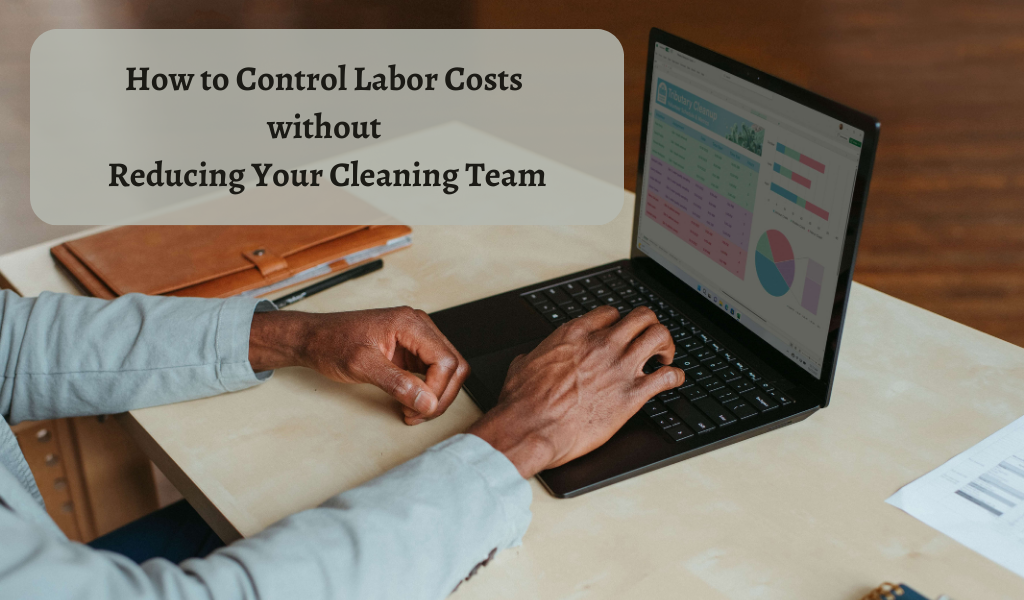You need to reduce expenses, but you can’t let any of your team go. Here’s how to control labor costs and make your business more profitable.
At some point, almost every commercial cleaning business will think about how to control labor costs, preferably without letting employees go. Labor costs are one of, if not the biggest expense for a business. And yet, unless you’re a single-person operation, you can’t run your business without employees or contractors.
In fact, labor costs are one of those tricky areas. You have to balance paying people enough so they stay with you, but not so much that your business can’t stay afloat.
On top of that, your team needs somewhat regular hours if you want them to stay with you. They can’t pay bills or make plans when they work 40 hours each week one month, then 25 hours a week the following month. If that happens often, they’ll find an employer that can offer them steady hours.
Of course, that makes it tempting to just lay people off when work slows down, and hire new people when things pick up. Some people may have luck doing that, but there are several reasons to think carefully about this approach:
- If you continually cycle through hiring people and letting them go, your best people will move on to a more steady gig.
- You run the risk of not having the people you need when a big job comes through.
- You spend a lot of time hiring, onboarding, and training.
- Your customers may end up with less-than-optimal service.
Where does that leave us? You want to figure out how to control labor costs while maintaining your current staffing levels and giving them consistent hours. While these may seem like opposites, they don’t have to be.
Ready to get your costs under control and watch profits soar? Reach out today for more info.

What goes into labor expenses?
When you’re looking at how to control labor costs, your first step is to figure out exactly what those costs are. If you’re just looking at hourly wages and hours worked, you’re missing a significant part of the equation. On top of wages, your costs may include unemployment taxes, liability insurance, workers’ compensation insurance, Medicare contributions, and so on. You may also need to include benefits such as health insurance and paid time off.
For the sake of ease, let’s just say your labor costs are $20 per hour, per employee. At 35 hours per week, that’s $700. Multiply that by 50 weeks (assuming two weeks off), and you have $35,000 per year in labor costs for each employee.
There are two ways to look at these labor costs: 1) the total number, or 2) as a percentage of your overall expenses. If you’re looking at the expense as a number, the only way to reduce or control that expense is to cut back on hours. At a minimum, you want to hold them steady at 35 hours.
Again, though, when you start cutting hours, your employees may start looking for other work. So, let’s say you don’t want to do that. This means we have to look at labor as a percentage of your overall expenses. That leads us to determining how to control labor costs in relation to your other business expenses and revenue.
How to control labor costs so your cleaning business can thrive
Here are some things to consider in thinking about how to control labor costs for your commercial cleaning company.
Does your payroll include much overtime? Overtime may be unavoidable at times. However, if you’re regularly running into overtime, it might be worth hiring someone part-time. And if you have several people on your team who are hitting overtime, you may even consider hiring another full-time person. You’ll need to weigh the specific costs here, but overtime adds up fast.
Are your employees buddy punching? Most people are honest and want to do right. But some people don’t mind working the system. One way that happens in the janitorial field is through buddy punching. Your buddy punches you in, even if you aren’t present. So you’re on the clock and getting paid without showing up to work. Obviously, this can destroy your labor budget. You aren’t only paying someone who isn’t working, but the person (or people) you are paying are working longer hours to make up for the absence. As an added “bonus,” this practice impacts the morale of your honest employees. One way to avoid this issue is to use software with facial recognition for clocking in and out.
Keep your equipment well-maintained. Well-maintained equipment will last longer and work more efficiently. And for controlling labor costs, when you take care of your equipment, it’s less likely to break down. That means your team is working instead of spending time dealing with emergencies.
Look for incentives. The federal government offers tax incentives, such as the Work Opportunity Tax Credit, ” for hiring and employing individuals from certain targeted groups who have faced significant barriers to employment.” Many states offer additional tax incentives or grants that may apply to your business, as well. It’s worth exploring your state’s Division of Commerce or Business Administration.
Look for other ways to reduce expenses. Labor might be your biggest expense, but it’s not your only expense. And there are almost always steps you can take to lower at least some expenses. Carefully track your supplies and inventory so you can always have what you need on hand. Work to retain your best employees, reducing the costs (and frustration) endemic to high turnover. Organize and streamline your scheduling so you always have a solid crew at every location you service.
As you think about how to control labor costs, remember to look at all these little things as part of the greater whole. Balance is the key to success.
Get labor costs under control with powerful scheduling and work loading tools. Get started now with a free call to Janitorial Manager to learn how mobile-friendly janitorial software can help you streamline your business.

